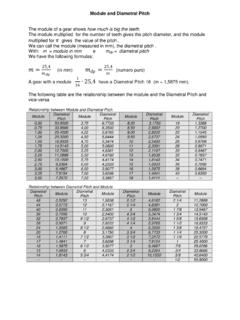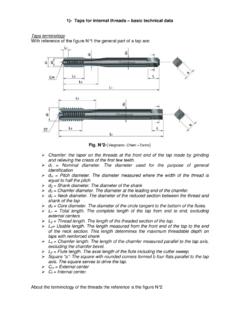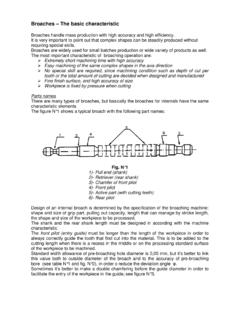Transcription of Materials used to manufacture hobs - Bianco …
1 Materials used to manufacture hobs There are many Materials that may be used for the manufacture of gear cutting tools and it is necessary to briefly examine this topic in order to understand how this sector has evolved, affecting both the performance of the tools themselves, their cost and their manufacturing capabilities. It is possible to make a distinction between two large categories of material with which gear cutting tools can be manufactured: a)- High speed steel b)- Carbide (sintered carbides) High speed steel High speed steels may be divided into normal high speed steels, also referred to as HSS and into high speed steels that are made of powder which are generally known as PM ( powder Metals).
2 The technical characteristics of the various types of steel depends very much on the so-called alloy components. In fact high speed steel is made up from a base of iron (Fe) which is mixed with carbon (C) and other precious metals such as vanadium (V), tungsten (W), chromium (Cr), molybdenum (Mo), cobalt (Co), etc. Combined with carbon, these compounds produce the so-called carbides that give the high speed steel properties of hardness, wear resistance and tenacity. The various percentages of alloy components give origin to the various types of high speed steel. In recent years there has been a great evolution in terms of cutting steels with a gradual improvement in technical characteristics so that today we have modern superalloy steels that can give performances that were unthinkable until just a few years ago.
3 It is a well-known fact that one of most fundamental laws of mechanics states that the harder a metal is, the more it is fragile. Diamond, for example, is the hardest material but it is also the most fragile. A good steel for cutting tools, however, must be as hard as possible while at the same time conserving a high level of tenacity. Modern metallurgy is in fact concentrating its efforts on improving these two characteristics. In table the compositions of the main types of high speed steel used today for the manufacture of gear cutting tools are indicated. We can immediately observe that the sum of all the alloy components passes from around 17% in the case of M2 to over 30% for some types of superalloy steel.
4 powder metals are produced with a technology that is different from traditional casting. In fact the components are first reduced to a very fine powder and they are then compacted together at a high temperature and under great pressure until a compact mass which is made up of the various carbides is obtained. The advantage of this type of steel is that the various carbides remain small in size and they are very well distributed within the steel mass. In traditional steel, on the other hand, one of the most serious inconveniences is that it is possible to obtain carbides which are notable in size and irregular in distribution ( in strips). See figure No. 1. Table Composition of the main types of high speed steel Sigla AISI e HRC obtainable Commercial abbreviation Chemical composition C Si Mn Cr W Mo V Co M2 (63,5 - 65) S600 0,90 4,10 4,60 5,00 1,80 idem EM25 0,90 4,20 6,40 5,00 1,80 idem ISORAPID 2000 0,89 4,30 6,40 5,00 1,90 idem THYRAPID 3343 0,90 4,10 6,40 5,00 1,90 idem DMO5 0,90 4,00 6,50 5,00 2,00 M2-PM (63,5 - 65) CPMREX M2 0,85 0,30 0,30 4,15 6,40 5,00 1,95 M35 (64 - 65,5)
5 S705 0,92 4,10 6,40 5,00 1,90 4,80 idem EM35 0,93 4,20 6,40 5,00 1,80 4,80 idem THYRAPID 3243 0,92 4,10 6,40 5,00 1,90 4,80 idem VASCO Commentry M35 0,84 0,30 0,30 4,20 6,35 5,00 1,90 4,75 idem EMO5CO5 0,92 4,10 6,40 5,00 1,90 4,80 M35 PM (64 - 65,5) CPMREX M35 0,85 0,30 0,30 4,15 6,00 5,00 2,00 5,00 M3-2PM (64 - 65,5) ASP 2023 1,28 0,30 0,30 4,10 6,40 5,00 3,10 idem APM 23 1,28 4,20 6,30 5,00 3,10 idem S790 1,28 4,20 6,30 5,00 3,00 Group F-PM(65-66,5) ASP 2030 1,28 4,20 6,40 5,00 3,10 8,50 idem HS 30 1,27 0,60 0,30 4,20 8,25 5,00 3,10 8,50 idem CPMREX 45 1,30 0,50 0,40 4,05 6,25 5,00 3,05 8,25 idem APM 30 1,29 4,20 6,30 5,00 3,10 8,40 idem S590 1,30 4,20 6,30 5,00 3,00 8,40 Group G-PM(64,5-66,5) ASP 2052 1,60 4,80 10,50 2,00 5,00 8,00 idem S390 1,60 4,80 10,50 2,00 5,00 8,00 Group H-PM(64,5-66,5) CPMREX 76 1,50 0,30 0,30 3,75 10,00 5,23 3,10 9,00 Group I PM (65 - 67) ASP 2060 2,30 4,20 6,50 7,00 6,50 10,50 Group L PM (65 - 67) CPM REX T15 1,55 0,30 0,30 4,00 12,25 5,00 5,00 M4 PM CPMREX M4 1,35 0,30 0,30 4,00 5,75 4,50 4,00 idem S690 1,33 4,30 5,90 4,90 4,10 Group N (65,5-69,5)
6 CPMREX 121 3,40 4,00 10,00 5,00 9,50 9,00 M42 (66,5 - 69) MO 88 1,08 3,90 1,50 9,40 1,20 8,00 idem EM 42 1,08 3,80 1,50 9,40 1,20 8,00 idem S 500 1,10 3,90 1,40 9,20 1,20 8,40 M34 (64,5 - 66,5) EMO 9 CO 0,92 4,00 2,00 8,00 2,00 8,00 Figure N 1- Comparison of distribution of carbides (Left: powder steel Right: forged steel) In fact it is very difficult to manage the dimensions and the distribution of carbides. Steel may therefore have a series of defects such as the non-uniformity of metallurgic characteristics, excessive hardness and fragility in some zones, poor machinability, high level of heat treatment deformation and so on. With powder metals it is possible to have more control over the size and distribution of the carbides and therefore the percentage of alloy components may be increased, bettering the cutting abilities of the tool.
7 One of the most important characteristics of high speed steels is the hardness which in general is measured in Rockwell degrees on the scale C (HRC= Hardness Rockwell C). The desired hardness is obtained by performing a correct Heat Treatment process. This is a very delicate operation and just a slight error in temperature or in the actual time that the steel is in the furnace may compromise the results. Heat treatment (hardening and tempering) is carried our either in a salt bath furnace or in a vacuum oven. In the first type of furnace, the workpieces are immersed in a crucible which is filled with dissolved salt (Barium chloride). The desired temperature is controlled by electrodes and it is regulated automatically and driven by thermocouples immersed in the salt bath; these thermocouples are more commonly known as immersed pyrometers.
8 Alternatively the bath temperature may be monitored by optic pyrometers which can measure the temperature according to the luminous radiation emitted by the bath. This type of heat treatment guarantees a good level of accuracy in terms of temperature and the workpieces immersed in the bath are heated in a uniform manner. The problems which salt baths generate are essentially of an ecological nature. Disposal of the waste tempering salts is very difficult and expensive. It is no longer legal to manufacture new units of this type. Another inconvenience of this system is that the workpiece must be carefully cleaned after heat treatment in order to avoid rapid oxidation and corrosion. Naturally the working environment where salt bath furnaces are installed is somewhat warm and especially in hot seasons, it is not very pleasant to be near such equipment.
9 Vacuum ovens are, on the other hand, essentially closed chambers which are placed under vacuum and in which the temperature is maintained at the desired level by a series of electrodes that are monitored by an electronic control system. This receives input from a series of thermocouples which are placed inside the oven. It would actually be incorrect to speak of vacuum treatment since it is true that air is aspired from inside the chamber until there is a pressure level of around 5310 Bar but Nitrogen (N) is then released into the chamber up to a pressure level of around 1,5 Bar. In the cooling phase Nitrogen is again released until the pressure level reaches up to even 8 Bar. The advantage of this type of oven is the cleanliness of the process, the surrounding working environment and the absence of products that may have a negative impact on the environment.
10 More precisely there are no ecological difficulties with this system. A disadvantage, however, of this system is that it is difficult to maintain a constant and uniform temperature within the chamber since it more sensitive to the characteristics of the load, that it the group of tools that are placed inside the oven for treatment. It is possible to obtain good results only after extensive experience and by paying a great deal of attention to the type of load and how it is arranged within the chamber. In any case good results are attainable on the workpiece only if the cycle indications that are given by the steel supplier are strictly adhered to. A typical treatment cycle could be the following for example: First pre-heating phase at 600 C for 10 20 minutes Second pre-heating phase at 800 C for 10 20 minutes Heating up to austenitic temperature at 1150 1250 C according to the type of steel at hand Drastic cooling down to 500 C Slow cooling until room temperature First tempering phase with heating up to around 550 C for at least 2 hours Cooling to room temperature Second tempering phase with heating up to around 560 C according to the desired hardness Cooling and final stress relieving phase to around 540 C.






